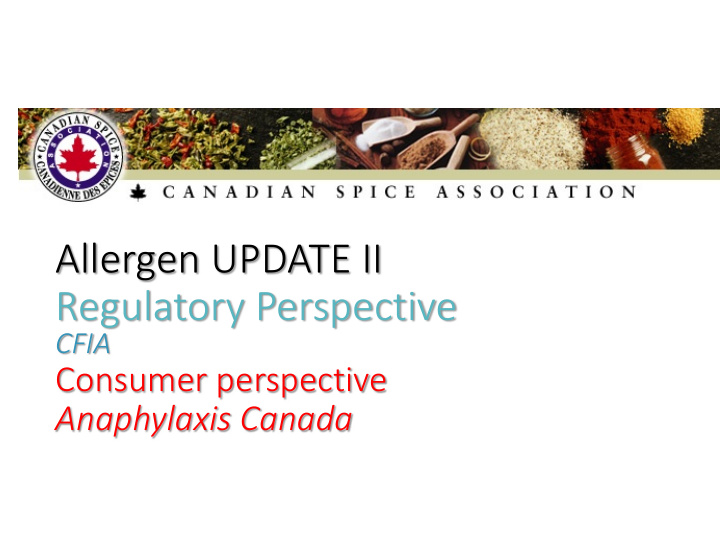



Allergen UPDATE II Regulatory Perspective CFIA Consumer perspective Anaphylaxis Canada
Regu gulator ory Persp spect ctive – Labelling g of F Food Al Allergens s • As of August 2012, priority allergens include: • The Food and Drug Regulations B.01.010.1(2) require that sources of the food allergen or gluten must be declared either in: • The list of ingredients • In a “contains” statement • Scope: Does not apply to a food allergen or gluten that is present in a prepackaged product as a result of cross- contamination. B.01.010.1(3) • , oats, rye, triticale and wheat
Regu egulatory Per ersp specti ctive – Inspect pections ns • As of August 2012, priority allergens include: • Inspection focus has been on undeclared allergens as a result of product formulations- not testing • 76 recalls from August 2012 to Feb. 2015 for undeclared mustard allergen 59 domestic 17 imported 35 class I 18 class II 23 class III
Food ood Al Aller ergen en Prec ecaut autiona nary S y Statem ements s (PL PL ) • As of August 2012, priority allergens include: • Voluntary statements regarding the possible inadvertent presence of an allergen in the food. • To be used when, despite all reasonable measures, the inadvertent presence of allergens in food is unavoidable. • Precautionary statements are not a substitute for Good Manufacturing Practices. • There is no regulatory requirement for, or prohibition of, precautionary labelling, however statements must be truthful and not misleading (FDA and CPLA). wheat
Co Consumer er p per erspec ective e • • About 2.5 million Canadians have self reported at least one food allergy , representing 7% of the population • There is no cure for food allergy; strict avoidance key to staying safe: • A small amount can trigger a reaction • Reading food labels , asking “What’s in the food?” •unintended Food labels are an allergic consumer’s life-line •unavoidable •naturally occurring
YET….the anaphylaxis community wants • Fewer products with precautionary statements • Wider choice of safe products • Standards for the food industry • Ongoing education of consumer “ Only 0 is good enough ” for acceptance of specific thresholds Millers would prefer to buy and process wheat and oats free of seeds, seed fragments and dust of all other crop types including, mustard, canola and soybeans. •
Allergen UPDATE III Thresholds
Thresholds • Undeclared allergens should not be present • If present , recall based on risk assessment: Risk assessments are based: -on amount of allergen in the product – in ppm - reference amount- qty of the food usually eaten by an individual at one sitting - level of exposure to an allergen which will trigger a reaction in an allergic individual
Thresholds cont`d Thresholds are based: - Individual allergen -on data which is very limited -LOAEL ( lowest observed adverse effect level) -No internationally agreed safe threshold levels -No clear definition of what is trace vs gross contamination
Thresholds cont`d • FARRP (Food Allergy research and Resource Program ) • Vital- ( Voluntary Incidental Trace Allergen Labelling ) • Eliciting dose ( ED) – trigger point at which 99% of allergic individuals will not trigger an allergic reaction
Allergen UPDATE IV Testing
Cor orrect ction on - Food ood R Recall Warning g - Resci cindment of of Food ood Recall Warnings ( (Allergen) • It is legal to sell cereal grains such as wheat, oats • laboratory testing indicated that cumin contained undeclared almond • additional testing has confirmed that the original laboratory results were false positives • Cross-reactivity with mahleb • Significant monetary and reputational cost for the manufacturer
Testing cont’d • Conflicting guidance on (PL) • Test methods: • Elisa- quantitative within a standard range • Some issues with cross-reactivity • PCR ( polymerase chain reaction)- qualitative-DNA • LOD • Sampling protocol
The way Forward for the spice industry • Supply chain improvement -How realistic to change agricultural methods in source countries? • Increased testing- - Expensive,time consuming and possibility of error • Individual risk assessment- - carries risk for the supplier • Industry-consumer-govt agreement on maximum threshold levels for each allergen that are science based –
The way forward for the spice industry • More and better science about health risk and thresholds of concern • Adoption of science-based action levels and maximum limits to reduce need for case by case risk assessments and recalls • Incorporation of MLs by reference into Food and compositional standards where science permits, compliance is achievable and, there is alignment with US guidance and practice
Is the spice industry able to ‘contain’ the use of ‘may contain’ ?
Recommend
More recommend